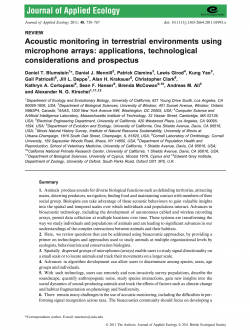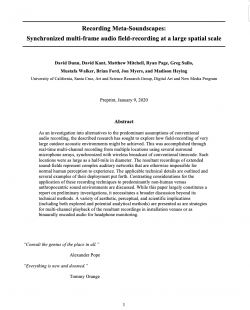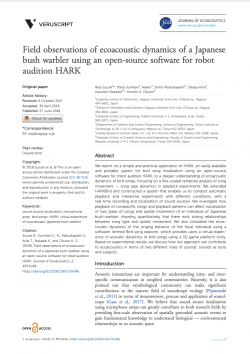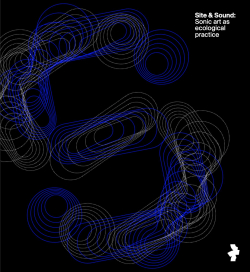Field test of an affordable, portable, wireless microphone array for spatial monitoring of animal ecology and behaviour
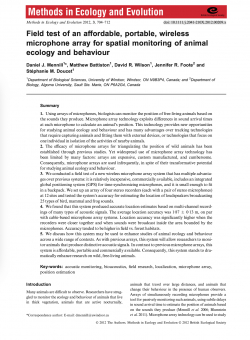
Type
Journal
Authors
Category
Article
[ Browse Items ]
Publication Year
2012
Publisher
Methods In Ecology and Evolution, United Kingdom
URL
[ private ]
Volume
3
Pages
704-712
Tags
Abstract
1. Usingarraysofmicrophones, biologists can monitor the position of free-living animals based on the sounds they produce. Microphone array technology exploits differences in sound arrival times at each microphone to calculate an animal’s position. This technology provides new opportunities for studying animal ecology and behaviour and has many advantages over tracking technologies that require capturing animals and fitting them with external devices, or technologies that focus on one individual in isolation of the activities of nearby animals.
2. The efficacy of microphone arrays for triangulating the position of wild animals has been established through previous studies. Yet widespread use of microphone array technology has been limited by many factors: arrays are expensive, custom manufactured, and cumbersome. Consequently, microphone arrays are used infrequently, in spite of their transformative potential for studying animal ecology and behaviour.
3. We conducted a field test of a new wireless microphone array system that has multiple advantages over previous systems: it is relatively inexpensive, commercially available, includes an integrated global positioning system (GPS) for time-synchronizing microphones, and it is small enough to fit in a backpack. We set up an array of four stereo recorders (each with a pair of stereo microphones) at 12 sites and tested the system’s accuracy for estimating the location of loudspeakers broadcasting 25 types of bird, mammal and frog sounds.
4. We found that this system produced accurate location estimates based on the multi-channel recordings of many types of acoustic signals. The average location accuracy was 1Æ87 ± 0Æ13 m, on par with cable-based microphone array systems. Location accuracy was significantly higher when the recorders were closer together and when sounds were broadcast inside the area bounded by the microphones. Accuracy tended to be higher in field vs. forest habitats.
5. We discuss how this system may be used to enhance studies of animal ecology and behaviour across a wide range of contexts. As with previous arrays, this system will allow researchers to monitor animals that produce distinctive acoustic signals. In contrast to previous microphone arrays, this system is affordable, portable and commercially available. Consequently, this system stands to dramatically enhance research on wild, free-living animals.
2. The efficacy of microphone arrays for triangulating the position of wild animals has been established through previous studies. Yet widespread use of microphone array technology has been limited by many factors: arrays are expensive, custom manufactured, and cumbersome. Consequently, microphone arrays are used infrequently, in spite of their transformative potential for studying animal ecology and behaviour.
3. We conducted a field test of a new wireless microphone array system that has multiple advantages over previous systems: it is relatively inexpensive, commercially available, includes an integrated global positioning system (GPS) for time-synchronizing microphones, and it is small enough to fit in a backpack. We set up an array of four stereo recorders (each with a pair of stereo microphones) at 12 sites and tested the system’s accuracy for estimating the location of loudspeakers broadcasting 25 types of bird, mammal and frog sounds.
4. We found that this system produced accurate location estimates based on the multi-channel recordings of many types of acoustic signals. The average location accuracy was 1Æ87 ± 0Æ13 m, on par with cable-based microphone array systems. Location accuracy was significantly higher when the recorders were closer together and when sounds were broadcast inside the area bounded by the microphones. Accuracy tended to be higher in field vs. forest habitats.
5. We discuss how this system may be used to enhance studies of animal ecology and behaviour across a wide range of contexts. As with previous arrays, this system will allow researchers to monitor animals that produce distinctive acoustic signals. In contrast to previous microphone arrays, this system is affordable, portable and commercially available. Consequently, this system stands to dramatically enhance research on wild, free-living animals.
Description
https://doi.org/10.1111/j.2041-210X.2012.00209.x
Number of Copies
1
| Library | Accession No | Call No | Copy No | Edition | Location | Availability |
|---|---|---|---|---|---|---|
| Main | 270 | 1 | Yes |
